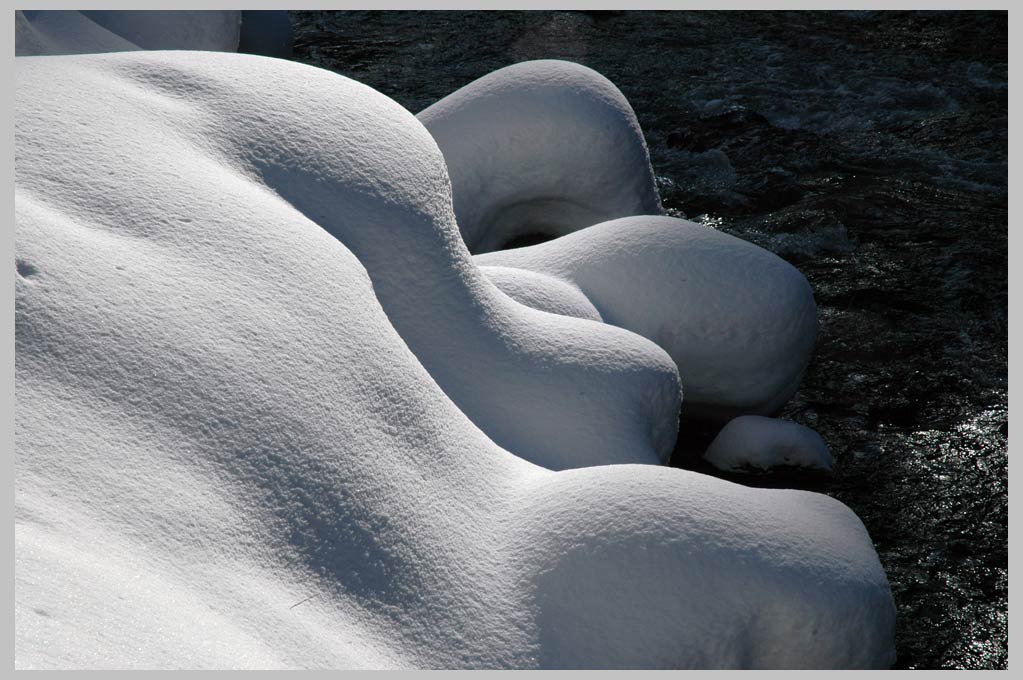

Snow Curves, flowforms, Eagle Creek at Martin Bridge, South Wallowas [ click photo for next . . . ]
On the road in the American Northwest.


Snow Curves, flowforms, Eagle Creek at Martin Bridge, South Wallowas [ click photo for next . . . ]
On the road in the American Northwest.
FLOWFORM?
Form emerges out of movement;
It is the outward envelope
of rhythmic pulse of change.
ON TWO DESTRUCTIVE EXCEPTIONS TO NATURAL MOVEMENT
The natural web of life—or how a great diversity of species are
knitted together in a weave of interdependencies—has deep
roots in both space and time. Its strength is not just its
resilience, but also its ability to quickly adapt to change.
These changes may be small and hardly noticeable, or
large-scale and catastrophic, but both are frequently initiated
by what are essentially chance events. The responses,
however, are anything but determined by chance, and are
rather swift adaptations shaped by, in the view being sketched
here, highly developed forms of natural intelligence. This
complementary back and forth of chance and necessity
results in a deeper formative ground which is remarkably
free of waste and contradiction.
Now, two uniquely problematic forms of movement which
are evidently not native to this web of life but which are
characteristic of humans and the artifacts which they produce
are: First, the total absence of movement, as for instance
where toxic wastes accumulate in life-web environments
as essentially dead, inert weights because of their inability
to break down and thereby become reassimilated as new
components of the natural cycle; Second, the other extreme
is exponential runaway growth. This occurs, for example,
when species which are not part of the life-web are for whatever
reason introduced and then go on to fragment the fabric of
interrelationships and dependencies. Because exponential
runaway growth is clearly growth which, as we say,is out of
control, it contradicts what I see as the universal principle
of natural limit.
It is evidently because both extremes violate the natural
order of movement that they are potentially so destructive.
They both place themselves, so to speak, outside of
natural movement by either refusing to move, as in the case
of the toxin that will not budge, or by refusing to stop moving,
as in the case of exponential runaway growth of, for example,
some weeds. One could say that both sides of this refusal defy
the central ordering principle of limit, which in turn is both the
complementary side of freedom and a key feature of the
dynamic balance of all self-sustaining natural cycles.
One expansion of this idea into the realm of finance that I'll
explore in another miniature is how the mathematics of
compound interest results in equally destructive cultural
movements: one grinding the debt of the already poor into
an absolute insoluble toxic standstill; the other running away
exponentially with more and more wealth going to the already
wealthy, seemingly without end or limit. Remarkably, in an
almost identical way to natural systems, this imbalance must
necessarily lead to total collapse. And also remarkably, the
key missing concept or feature is again simply limit. A balanced,
free economy, in my view, must of necessity be a strictly limited
one. Just like an essentially self-organizing network of streaming
pathways—either for cars or for digital data, it makes no difference—
there must be a small, explicit, unambiguous set of clear rules for
what is not allowed: not faster than, not on that side of the road,
turn here, stop there, etc. In an economy, these speed limits on
wealth would instantly insure a vastly more equitable distribution
of essential resources among all the peoples of the world
community. Like Gandhi famously said: "The Earth provides
enough for man's need, but not for his greed." We would do well,
I think, to redesign our cultural systems to conform organically to
the demonstrably more creative intelligence of the natural world
by taking this fundamental insight as our basic point of
departure.
THE LITTLE CLAVIER please preview 150 of 631 pages
w/ my black & white photography [opens in new window]
NEW: To view / purchase high quality prints & matted frames
at the Photoweek Northwest online store, SLIDESHOW
http://picturepoems.zenfolio.com/
All Photographs & texts by Cliff Crego © 1998-2014 picture-poems.com
(created: X.11.2008)